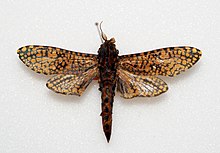| Cossoidea | |
|---|---|

| |
| Cossidae spp. | |
| Scientific classification | |
| Domain: | Eukaryota |
| Kingdom: | Animalia |
| Phylum: | Arthropoda |
| Class: | Insecta |
| Order: | Lepidoptera |
| Infraorder: | Heteroneura |
| Clade: | Eulepidoptera |
| Clade: | Ditrysia |
| Clade: | Apoditrysia |
| Superfamily: | Cossoidea Leach, [1815] |
| Families | |
|
Cossidae - carpenter moths | |
| Diversity | |
| about 676 species | |
Cossoidea is the superfamily of moths that includes carpenter moths and relatives. Like their likely sister group Sesioidea they are internal feeders and have spiny pupae with moveable segments to allow them to extrude out of their exit holes in stems and trunks during emergence of the adult (Edwards et al., 1999).
The Limacodidae are sometimes included here as a third family. But the Sesioidea, and perhaps the Zygaenoidea and/or Tortricoidea, seem to be close relatives of the Cossoidea, and the relation of these – in particular the Zygaenoidea – to the Limacodidae requires further study.
References[edit]
- Edwards, E.D., Gentili, P., Horak, M., Kristensen, N.P. and Nielsen, E.S. (1999). The cossoid/sesioid assemblage. Ch. 11, pp. 181–185 in Kristensen, N.P. (Ed.). Lepidoptera, Moths and Butterflies. Volume 1: Evolution, Systematics, and Biogeography. Handbuch der Zoologie. Eine Naturgeschichte der Stämme des Tierreiches / Handbook of Zoology. A Natural History of the phyla of the Animal Kingdom. Band / Volume IV Arthropoda: Insecta Teilband / Part 35: 491 pp. Walter de Gruyter, Berlin, New York.
- van Nieukerken, Erik J.; Kaila, Lauri; Kitching, Ian J.; Kristensen, Niels P.; Lees, David C.; Minet, Joël; Mitter, Charles; Mutanen, Marko; Regier, Jerome C.; Simonsen, Thomas J.; Wahlberg, Niklas; Yen, Shen-Horn; Zahiri, Reza; Adamski, David; Baixeras, Joaquin; Bartsch, Daniel; Bengtsson, Bengt Å.; Brown, John W.; Bucheli, Sibyl Rae; Davis, Donald R.; De Prins, Jurate; De Prins, Willy; Epstein, Marc E.; Gentili-Poole, Patricia; Gielis, Cees; Hättenschwiler, Peter; Hausmann, Axel; Holloway, Jeremy D.; Kallies, Axel; Karsholt, Ole; Kawahara, Akito Y.; Koster, Sjaak (J.C.); Kozlov, Mikhail V.; Lafontaine, J. Donald; Lamas, Gerardo; Landry, Jean-François; Lee, Sangmi; Nuss, Matthias; Park, Kyu-Tek; Penz, Carla; Rota, Jadranka; Schintlmeister, Alexander; Schmidt, B. Christian; Sohn, Jae-Cheon; Solis, M. Alma; Tarmann, Gerhard M.; Warren, Andrew D.; Weller, Susan; Yakovlev, Roman V.; Zolotuhin, Vadim V.; Zwick, Andreas (23 December 2011). Zhang, Zhi-Qiang (ed.). "Order Lepidoptera Linnaeus, 1758" (PDF). Zootaxa. Animal biodiversity: An outline of higher-level classification and survey of taxonomic richness. 3148: 212–221.
Sources[edit]
- Firefly Encyclopedia of Insects and Spiders, edited by Christopher O'Toole, ISBN 1-55297-612-2, 2002
External links[edit]
Well, that’s interesting to know that Psilotum nudum are known as whisk ferns. Psilotum nudum is the commoner species of the two. While the P. flaccidum is a rare species and is found in the tropical islands. Both the species are usually epiphytic in habit and grow upon tree ferns. These species may also be terrestrial and grow in humus or in the crevices of the rocks.
View the detailed Guide of Psilotum nudum: Detailed Study Of Psilotum Nudum (Whisk Fern), Classification, Anatomy, Reproduction